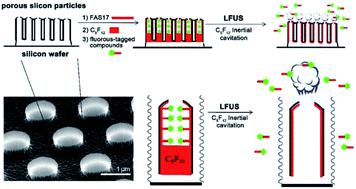当前位置:
X-MOL 学术
›
Nanoscale Adv.
›
论文详情
Our official English website, www.x-mol.net, welcomes your feedback! (Note: you will need to create a separate account there.)
A fluorous biphase drug delivery system triggered by low frequency ultrasound: controlled release from perfluorous discoidal porous silicon particles
Nanoscale Advances ( IF 4.7 ) Pub Date : 2020-06-30 , DOI: 10.1039/d0na00324g Jing Liu 1 , Shuo Li 1 , Lina Liu 1 , Zhiling Zhu 1
Nanoscale Advances ( IF 4.7 ) Pub Date : 2020-06-30 , DOI: 10.1039/d0na00324g Jing Liu 1 , Shuo Li 1 , Lina Liu 1 , Zhiling Zhu 1
Affiliation

|
Conventional drug delivery systems face unsatisfactory loading efficiency, poor biological bypass, and uncontrollable release, which are great barriers for improving the treatment of many diseases. Herein, a proof-of-concept of a fluorous biphase drug delivery system (FB-DDS) trigged by low frequency ultrasound (LFUS) is proposed for the first time, where promoted incorporation and stabilization of therapeutic agents in nanocarriers was achieved through fluorine–fluorine interactions, and the encapsulated drugs were controllably released by external sources, resulting in minimized nonspecific toxicity and enhanced therapeutic efficacy. The FB-DDS was constructed from monodisperse, discoidal porous silicon particles (PSP) and was functionalized with 1H,1H,2H,2H-perfluorodecyltrimethoxysilane (FAS17) for loading perfluoropentane (PFP) and fluorinated drugs through fluorine–fluorine interactions. This delivery system was demonstrated by utilizing model compounds including a fluorous-tagged fluorescein and a fluorine containing antibiotic ciprofloxacin. Loading of the model molecules into fluorocarbon-coated carriers was facilitated by fluorous interactions, whereas ejection of the model molecules was promoted by applying LFUS to rapidly evaporate PFP. In the in vitro test, these carriers loaded with fluorine containing ciprofloxacin exhibited excellent antimicrobial activity against Pseudomonas aeruginosa biofilm formation. Overall, this innovative stimulus-responsive fluorous biphase drug delivery system will be a promising candidate for practical applications as well as encouraging further investigation of drug delivery and controlled release strategies.
中文翻译:

低频超声触发的含氟双相给药系统:全氟盘状多孔硅颗粒的控制释放
传统的药物递送系统面临着装载效率不理想、生物旁路不良、释放不可控等问题,这些都是提高许多疾病治疗水平的巨大障碍。在此,首次提出了由低频超声 (LFUS) 触发的含氟双相药物递送系统 (FB-DDS) 的概念验证,其中通过氟促进治疗剂在纳米载体中的掺入和稳定化——氟相互作用,并且封装的药物由外部来源可控释放,从而最大限度地减少非特异性毒性并提高治疗效果。FB-DDS 由单分散盘状多孔硅颗粒 (PSP) 构成,并用 1 H ,1 H ,2 H ,2官能化H-全氟癸基三甲氧基硅烷 (FAS17),用于通过氟-氟相互作用装载全氟戊烷 (PFP) 和氟化药物。该递送系统通过使用包括氟标记的荧光素和含氟抗生素环丙沙星在内的模型化合物得到证实。氟相互作用促进了将模型分子加载到碳氟化合物涂层载体中,而通过应用 LFUS 快速蒸发 PFP 促进了模型分子的喷射。在体外试验中,这些载有含氟环丙沙星的载体对铜绿假单胞菌表现出优异的抗菌活性生物膜的形成。总体而言,这种创新的刺激响应型含氟双相药物递送系统将成为实际应用的有希望的候选者,并鼓励进一步研究药物递送和控释策略。
更新日期:2020-08-11
中文翻译:

低频超声触发的含氟双相给药系统:全氟盘状多孔硅颗粒的控制释放
传统的药物递送系统面临着装载效率不理想、生物旁路不良、释放不可控等问题,这些都是提高许多疾病治疗水平的巨大障碍。在此,首次提出了由低频超声 (LFUS) 触发的含氟双相药物递送系统 (FB-DDS) 的概念验证,其中通过氟促进治疗剂在纳米载体中的掺入和稳定化——氟相互作用,并且封装的药物由外部来源可控释放,从而最大限度地减少非特异性毒性并提高治疗效果。FB-DDS 由单分散盘状多孔硅颗粒 (PSP) 构成,并用 1 H ,1 H ,2 H ,2官能化H-全氟癸基三甲氧基硅烷 (FAS17),用于通过氟-氟相互作用装载全氟戊烷 (PFP) 和氟化药物。该递送系统通过使用包括氟标记的荧光素和含氟抗生素环丙沙星在内的模型化合物得到证实。氟相互作用促进了将模型分子加载到碳氟化合物涂层载体中,而通过应用 LFUS 快速蒸发 PFP 促进了模型分子的喷射。在体外试验中,这些载有含氟环丙沙星的载体对铜绿假单胞菌表现出优异的抗菌活性生物膜的形成。总体而言,这种创新的刺激响应型含氟双相药物递送系统将成为实际应用的有希望的候选者,并鼓励进一步研究药物递送和控释策略。



























 京公网安备 11010802027423号
京公网安备 11010802027423号